How To Remove Galvanized Coating
Galvanized steel has a zinc coating to protect it from rusting. Simply when you want to weld it, it's best to remove the galvanized blanket to avoid many issues.
This article starts with an overview of the welding bug that zinc creates, the basic protection when yous remove information technology, and six means to exercise information technology.
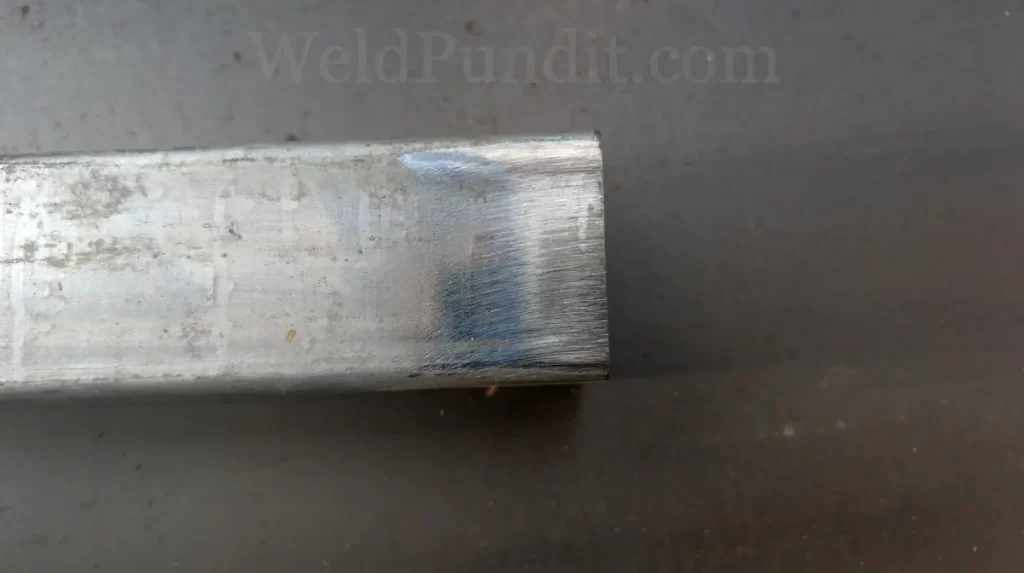
Problems when welding over galvanized coating
The galvanized coating has a low melting and boiling point. The welding heat volition plow it into liquid zinc and white fumes. Zinc introduces or worsens many welding bug, for example:
- The large amount of zinc fumes tin can brand you sick with metal smoke fever (pubmed.gov). Furthermore, hot-dipped galvanization might contain traces of pb or chromium.
- Liquid zinc tin can penetrate the bead and the heat-affected zone (HAZ). The HAZ is the expanse next to the dewdrop. Under harsh service weather, this tin can lead to cracking.
- Excessive spatter and fume that stick to all sounding surfaces, including MIG or TIG torches.
- Excessive porosity in the weld metal.
- Lack of fusion along the articulation.
- Depression root penetration.
- Inclusions in the weld metallic.
- Harder arc strikes.
When you remove the zinc coating, yous eliminate or reduce these bug. Even if in that location is some zinc residue left, it will:
- Not have negative furnishings on the joint strength for typical abode or small workshop projects.
- Generate merely a fraction of boosted fumes.
- Reduced spatter and popping will allow the usage of MIG welding.
Depending on the metal's thickness, y'all remove the zinc blanket from the joint past one-3″ (two.5-7.v cm). Yet, there is some other result.
You need to remove the zinc coating all around the joint
When metals get hot, they will melt and vaporize the zinc blanket, fifty-fifty if the puddle is at a distance. That makes information technology difficult to avoid the zinc problems if you just make clean the side you lot will weld.
An example of this is when white smoke escapes from inside a square or round tube.
But it becomes worse when you take a thick tee articulation or a lap joint because the areas that bear upon volition trap the zinc inside. The trapped gases volition often escape through the puddle, and the liquid zinc may crack your weld.
To avoid this, yous want to remove the galvanized coating on every surface around the articulation equally much as possible.
Precautions when removing galvanized coating
All removal methods release air pollutants such every bit dust, fumes, vapors, and gases. The basic steps to avoid exposing yourself to air pollutants are:
- Endeavour to work outside so that the air dilutes and drives away the pollutants.
- If you desire to work indoors, leave windows and doors open up and use ventilation. Local ventilation is the best because it captures the pollutants at their source. Later that, use mechanical ventilation to pull or button the pollutants outside without passing them through y'all.
- Always go on your caput abroad from the pollutants' path.
- For added protection, use a quality respirator with P100 filters or gas cartridges to capture whatever remaining hazards.
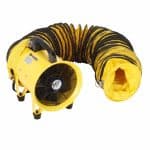


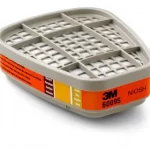
Weldpundit has in-depth manufactures on protecting yourself from welding fumes and gases and welding respirators for domicile welders.
The galvanized coating is tough and firmly attached to the steel, but the following six methods can remove information technology:
ane. Grinding is the most practical method
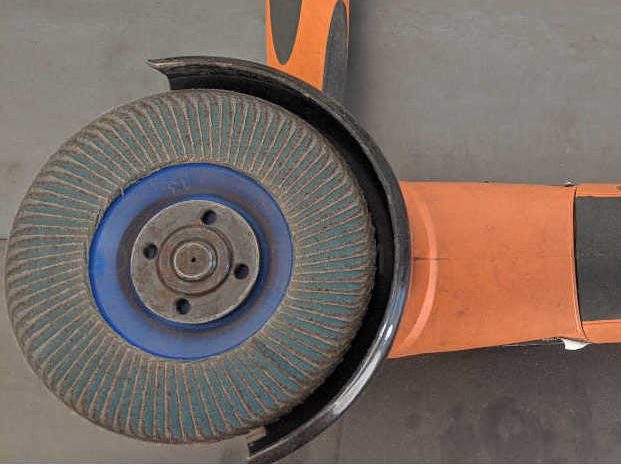
The nigh mutual, fast, and easy way to remove galvanized coating next to the joint is to use an angle grinder. A bench grinder can besides be useful for pocket-sized workpieces.
For almost jobs, y'all can apply a coarse 36 grit flap disc. When you lot outset grinding the coating, the sparks are few, curt, and reddish. When the grinder starts to create the sparks of clean steel, most of the zinc is gone.
Merely if yous have thick hot-dipped galvanization, a grinding disc would be more suitable. That'southward because zinc tends to clog flap discs.
Silicon carbide (SiC) is the best abrasive to remove galvanized coatings. Silicon carbide can detach coatings with higher efficiency than aluminum oxide or zirconia abrasives. That helps to reduce zinc residue and clogged discs.
The problem with grinding is that zinc tends to smear over the area. As a result, grinding cannot remove 100% of the zinc coating.
If y'all attempt to grind to perfection, you volition start removing metal, resulting in thinner metal next to the joint.
If the galvanization is sparse, a knotted wire cycle can also remove most of the zinc without removing metal.
Grinding doesn't do a perfect job, but welding will quickly burn the remaining zinc. Therefore, there volition be no noticeable furnishings on the articulation and merely a fraction of additional welding fumes.
Grinding reduces spatter and porosity enough to use MIG welding, only non TIG welding.
If you want to remove the remaining zinc, you need the assistance of an additional method, for case, a flame torch to fire it.
Another negative is that grinding cannot clean the inside surface of minor foursquare or circular tubes and other hard-to-reach areas.
The master air pollutant of grinding is dust. Dust from galvanized steel is more harmful than dust from rust or mill calibration.
Local ventilation is the best mensurate if you have a lot of work to exercise. A welding respirator is as well effective against dust particles.
An angle grinder is a high-speed tool that can propel particles or, even worse, broken discs at loftier speeds. It would be best to wear safety spectacles and a full-face mask.
Also, grinding is very noisy, and it would be wise to use ear protection to avoid long-term hearing problems.
two. Flame cleaning doesn't get out zinc residue

High estrus can remove galvanized coatings. If you have a flame torch or even meliorate access to oxyfuel equipment, yous can utilise the flame cleaning technique to make clean the articulation.
You lot prepare an oxidizing flame and position it at an bending virtually parallel to the workpiece. Then motion it along the joint to fire the coating. When zinc starts to bit, you can use a wire brush for faster results.
Flame cleaning tin remove thick galvanization without damaging the metal and leaves a smooth surface without residual zinc. It'south as well suitable for hard-to-reach areas.
But, if you don't move the flame fast enough, the full-bodied heat tin warp thin metals.
Flame cleaning creates a huge amount of fumes, far more than welding. The best affair to do is work exterior and wear a welding respirator.
3. A chisel and a hammer won't pollute the air
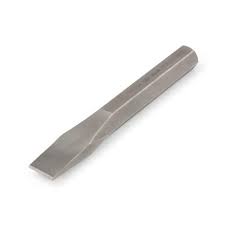
If you accept a very thick coating, you can use a chisel and a hammer to remove it. This solution is tedious and needs transmission endeavor, but it doesn't release dust or fumes into the air. It'south too the cheapest one.
iv. Long arcing as a fast but dirty solution
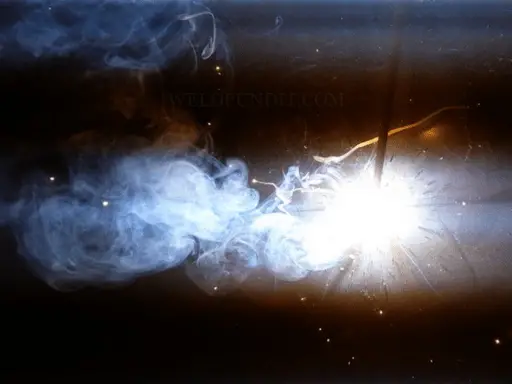
If you have stick welding equipment, you can use an unorthodox way to burn most of the galvanized coating.
You lot tin can use a long arc and pass information technology with a fast traveling speed over the articulation one or two times. A long arc will create a larger and hotter arc that will burn most of the zinc, even if information technology's thick.
This method will create a lot of spatter and fumes. But it'due south amend than zilch if the coating is as well thick to weld.
v. Abrasive blasting for loftier productivity
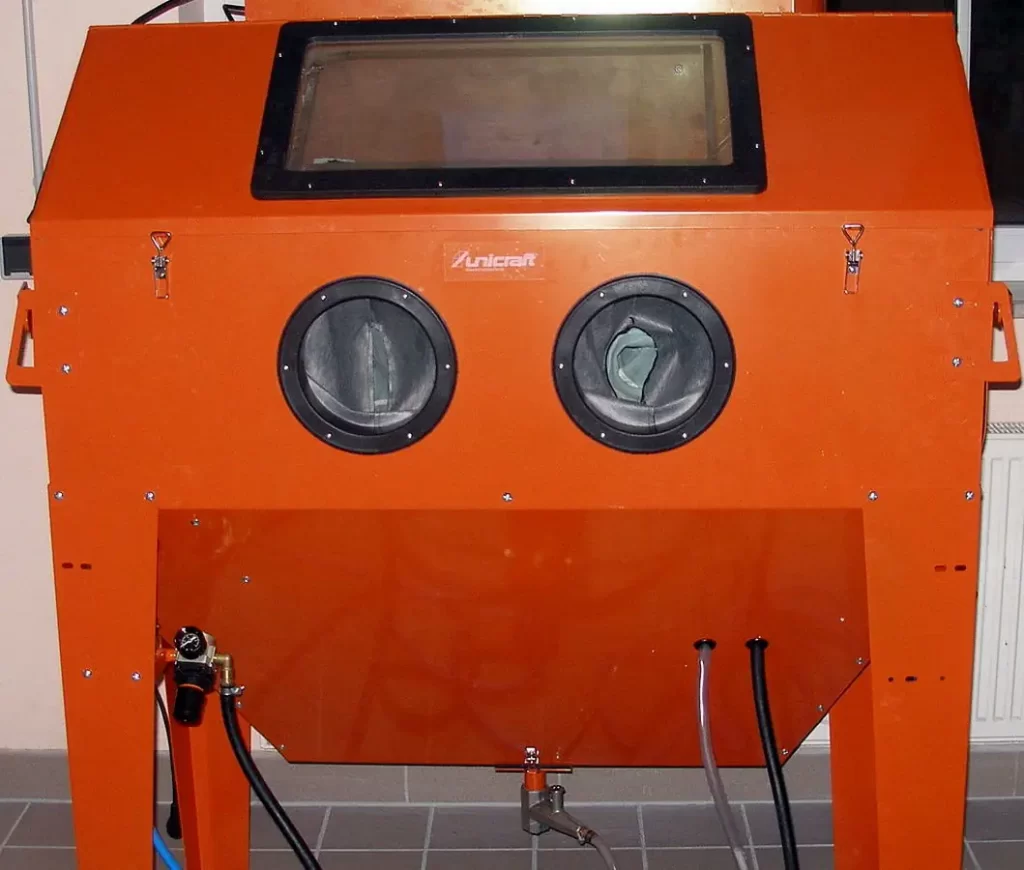
Abrasive diggings is an aggressive method that uses loftier-speed abrasive particles to remove thick galvanized coatings at fast rates. It can as well clean difficult-to-achieve areas.
The most well-known blazon is sandblasting, which uses sand and a large air compressor. However, natural sand creates a fine dust cloud so harmful that many countries banned it. That's because sand contains silica (90%+) in the course of quartz.
Other well-known blasting materials (or media) that can remove galvanized blanket are:
- Aluminum oxide.
- Silicon carbide.
- Garnet.
- Chilled iron grit.
- Steel grit.
- Sand with a pocket-size amount of silica (2%).
The effectiveness of abrasive blasting as well depends on the media grit size and the speed it comes out of the nozzle.
The diggings force generates a lot of dust, both from the media and the coating. Furthermore, high-speed particles can damage exposed or lightly protected skin.
The nearly applied method for your safety is to use a cabinet to isolate the dust and the high-speed particles. This way, yous can use this method indoors. The chiffonier can as well recycle the media, making it more economical in the long run.
Nevertheless, a cabinet is only useful for small workpieces that can fit inside.
Without a blasting chiffonier, y'all need to work outdoors and wear protective equipment suitable for abrasive blasting that covers your entire body.
Blasting is and then aggressive that it tin overheat and impairment sparse metal if you keep the nozzle steady. Furthermore, blasting can leave abrasive remainder on the metal.
6. Acids are efficient but most have safe bug
Near acids are capable of removing galvanization and are oft used to clean the entire workpiece. Many blanket removal products contain these acids and other chemicals, making them more expensive but safer to use.
Removing the coating with acids has some benefits:
- You lot avoid the dust particles of grinding and sandblasting, or the fumes of flame cleaning.
- They don't exit zinc rest.
- Weak acids don't remove metallic as grinding, merely given plenty time the stronger ones will.
- Finally, different flame cleaning and sandblasting, acids don't warp thin metals.
However, many acids are very corrosive and have their ain serious safety bug for:
- The skin and eyes.
- The unabridged respiratory arrangement.
- Clothes and equipment.
- Strong acids also have legal bug.
Most acids release vapors and gases of various volumes and toxicity. For this, you lot should always use them outside. Even if you employ ventilation and respirators, the harmful concentrations can exceed their capabilities in a confined area.
Furthermore, ordinary respirator filters made for welding cannot capture these pollutants. Acid vapors and their byproducts need specialized gas cartridges.
Weak acids are cheap and pretty safe
The recommended acids to remove galvanized coatings are acetic acid and citric acrid. Acetic is the acrid in vinegar, and citric is the acrid in lemons.
These acids are pretty prophylactic for occasional usage since they have low corrosion power. Furthermore, you utilise them in low concentrations, for case, vinegar has only 5% acetic acid.
- They do not generate vapors at fast rates and release minimal amounts of hydrogen.
- They cannot irritate the pare without long exposure.
- Finally, they are cheap to buy and simple to apply.
The disadvantage of these weak acids is that they take a long time to remove coatings. Depending on the zinc thickness, acid density, and temperature, it might have from one 60 minutes up to a whole day.
Allow's meet how to use vinegar to remove galvanized coating:
- Put the workpieces in a clean plastic container.
- Fill the container with enough vinegar to cover them.
- Exit them for a couple of hours. You ever get out the container open.
- Test them with a wire brush to see how much of the coating has dissolved.
- When the coating is gone, rinse and dry the workpieces.
I prefer citric acrid because it's odorless and cheaper since it'due south easy to observe in concentrated form.
It also doesn't create wink rust as easily as vinegar. Flash rust is a thin rust layer that forms rapidly on wet metals. It'south common when you clean metals with acids.
You lot can buy some citric acid from your local supermarket'south food section and try it.
To use citric acid, make full a plastic container halfway with water and add 5% acid. You can increase the percentage to 10% for quicker results. And then mix it until information technology dissolves, and follow the previous process for vinegar.
Afterward the recommended weak acids, there are many stronger ones. Every bit acids increase in corrosive power, y'all get up to the popular simply unsafe muriatic acid.
Dangers of muriatic acrid
Muriatic acid is a cheap and diluted class of muriatic acid (Wikipedia link). It can remove thick galvanized coatings in a couple of minutes, or even less.
Even so, hydrochloric acid has many prophylactic issues:
- Muriatic acid tin chemically burn your skin and cause permanent eye damage.
- Inhaled vapors tin damage the unabridged respiratory system.
- Muriatic vapors or acid residue on metals are converted to toxic gases when they come into contact with heat (the puddle or heated metals). The same happens when they react with the arc's ultraviolet rays. These gases are more than harmful than welding fumes.
- When muriatic acid cleans metals, it releases loftier amounts of combustible hydrogen. If hydrogen concentrates in the air, it tin ignite with explosive forcefulness.
- If muriatic acid comes in contact with other cleaning chemicals, it volition release toxic gases. Use only water to dilute information technology.
- Muriatic acid tin harm your clothes and most equipment it lands on.
- If you forget the workpieces in this acid, they will offset to lose textile.
- Muriatic vapors will cause flash rust on all unprotected ferrous metals they bear on.
- If you illegally dispose of hydrochloric acid, you adventure paying a large fine at all-time. Ask your local recycling middle before you utilise it.
Muriatic acid or any other chlorinated products must not be used in welding or hot cutting areas.
How to safely use hydrochloric acid for welding
Muriatic acid was extensively used in domestic cleaning and many people are familiar with it. If you decide to utilise it on galvanized steel, you demand to utilise many safety precautions:
- Since hydrochloric acid is so harmful, ever use information technology outdoors and away from other people or pets.
- You lot need to wear full-body prophylactic personal protective equipment (PPE) that are acid-resistant. The respirator must cover the entire face to protect the eyes, too. Furthermore, the respirator needs gas cartridges for chloride vapors.
- Use heavy-duty plastic containers and long pliers to handle the workpieces.
- Since muriatic acid is then corrosive, you can dilute it with water to make it safer. It volition still exist stiff enough to remove the galvanization in minutes. Yous can apply ane part acid upward to x parts of water.
- Ever dilute the acrid into h2o, never water into the acid.
- Fill the plastic container only halfway to keep the acrid inside when you work.
- Dip the workpieces slowly to avoid spilling acrid.
- When you take the workpieces out, you must rinse them with h2o. Then dip them in another container that has a solution of water and blistering soda. This solution volition naturalize whatsoever remaining acid on them. Finally, rinse the workpieces again and dry them.You cannot avoid this if you want to weld or hot-cut them.
- The last step is to dispose of the acid. Every bit mentioned before, you desire to know how to do it legally. Remember that now it might comprise traces of atomic number 82. The recycling heart might desire to handle information technology themselves or instruct you how to naturalize it, for example, with a blistering soda solution.
Since muriatic acid is and so effective, yous tin remove the zinc blanket locally. If you have a long joint:
- You tin can use tape along the joint and leave exposed only the area you want to remove the coating. This way, you protect the remaining galvanization.
- Subsequently that, yous apply the acid to the exposed area with a castor or a spray bottle.
- Then, rinse the area and apply a baking soda solution.
- Finally, rinse again. This will ensure there is no acid residue left.
If y'all want to remove galvanization at the edges of long workpieces such equally pipe or tubing, you lot can:
- Dip the edges in 1-2″ of acrid.
- Then rinse the area and dip them again in a blistering soda solution.
- Finally, rinse once more. This method will remove the coating inside and outside.
In a nutshell
Grinding is the best way to remove the galvanized coating for nearly welding projects. Yet, information technology leaves zinc residual.
Weak acids such every bit acetic and citric acid are safe, but they crave a long time to remove galvanization.
Flame cleaning doesn't get out zinc residue, just it will generate a lot of zinc fumes.
A chisel and a hammer work against thick coatings. This method volition not release air pollutants, just it'due south slow.
Long arcing is a messy method, roofing every surface with spatter and smoke. But it can burn most of the coating.
Annoying blasting is fast only requires full-torso protection except if yous use an isolation cabinet.
Corrosive acids such equally hydrochloric acid are efficient simply unsafe in many means. Citric acid is safe but slow.
Weldpundit manufactures
- Can You lot Weld Galvanized Steel? All-time Beginner's Guide.
- Can You Weld Galvanized Steel with a MIG Welder?
- What Is Manufacturing plant Scale on Hot-Rolled Steel: And How to Weld Through It
- Can You Weld Rusty Metallic? Problems and Best Options
- Welding Helmet Fogging upwardly? ten Ways to Prevent Information technology.
- Tin You Acquire Welding on Your Own? What Practise You Demand.
- Can You Weld Magnetized Metallic? And How to Demagnetize It.
- The Welding Arc Blow Guide: Causes, Defects, Remedies.
Source: https://weldpundit.com/remove-galvanized-coating-welding/

0 Response to "How To Remove Galvanized Coating"
Post a Comment